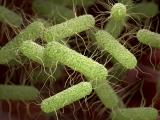Nov 19, 2009
Study: H5N1 needs double mutation to gain human transmissibility
A team of British and American researchers say their experiments suggest that the H5N1 avian influenza virus would have to undergo at least two simultaneous mutations to gain the ability to spread easily from human to human. Writing in the journal PLoS One, the scientists state that the hemagglutinin protein of H5 flu viruses can bind to only one of the two main types of cells in the human airway. They introduced selected mutations into recombinant H5 hemagglutinins and tested their ability to bind to airway cells. The team found that two simultaneous mutations were necessary to confer this binding ability, and that intermediate forms of hemagglutinin with just one mutation lacked the ability. In a news release, senior author Wendy Barclay said the findings suggest that the chance of this kind of double mutation occurring naturally is extremely low, but not nonexistent.
PLoS One report
Nov 18 EurekAlert release
Egypt reports H5N1 infection
Egypt's health ministry reported that a 21-year-old man from Alexandria governorate got sick with an H5N1 avian influenza infection after helping slaughter sick birds, Egypt's Strengthening Avian Influenza Detection and Response (SAIDR) site reported yesterday. If the World Health Organization (WHO) confirms the case, it will be listed as the country's 88th H5N1 infection. The man came down with a fever and breathing problems on Nov 11 and was hospitalized and given oseltamivir (Tamiflu) on Nov 15. He is reported to be in stable condition.
WHO: Cape Verde hit by first dengue fever outbreak
An international team of health experts is in Cape Verde, an island nation off West Africa, to help the country manage its first dengue fever outbreak, the WHO reported yesterday. The country's health ministry said 16,744 suspected cases have been reported on five islands. Since the outbreak is Cape Verde's first, the population lacks immunity to the disease, and infection rates could reach 40% to 50%, or even 80% to 90% in the worst case, the WHO said in a statement. The WHO has provided personal protective equipment, larvicide, insect foggers, and diagnostic supplies to help the government respond to the outbreak. It and the Cape Verde health ministry have also set up Internet and text-messaging systems to assist public health teams and share urgent information on the disease with people who are at risk for dengue infections.
Nov 18 WHO statement
Leaky reservoir blamed for Colorado Salmonella outbreak
Contamination of a city reservoir by animal waste was the probable cause of a waterborne Salmonella outbreak in Alamosa, Colo., in March and April 2008, the Colorado Department of Public Health and Environment (CDPHE) said in its final report on the episode. The outbreak involved 442 illnesses and one death. The CDPHE concluded that several small cracks and holes in a storage reservoir near the city's primary well probably allowed fecal contamination to enter the water. The city did not chlorinate its water before the outbreak, but since then it has installed advanced treatment processes and improved system operations, the report said.
CDPHE's Alamosa outbreak page



















